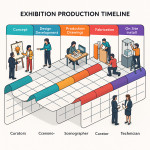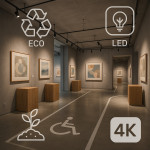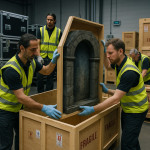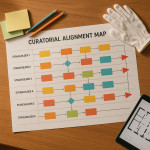Eco-smart materials roadmap for exhibition scenography that cuts waste costs
Looking to slash disposal fees and carbon footprints without sacrificing wow-factor? This roadmap walks you through proven eco-smart materials, sourcing tactics and design loops that drive down waste costs in exhibition scenography. You will leave with actionable benchmarks, supplier tips and budget calculators to future-proof every build.
Why eco-smart materials matter to your bottom line
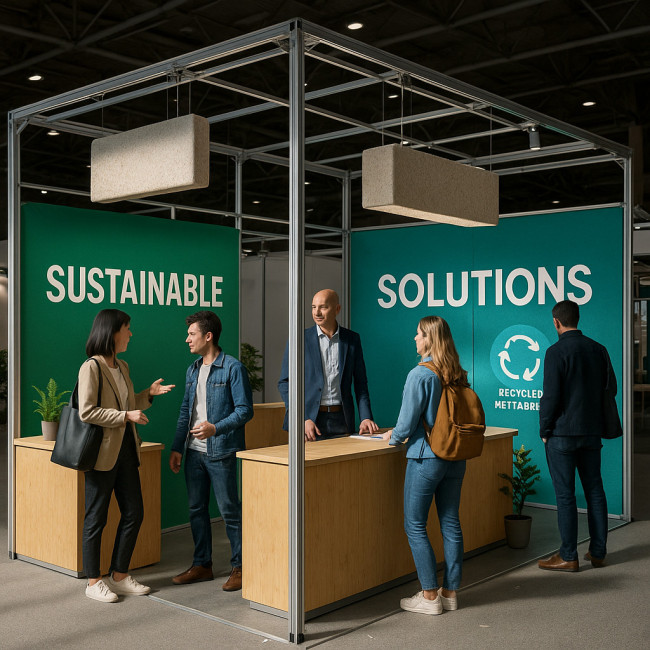
Single-use MDF walls and vinyl wraps still dominate trade-fair show floors, yet they account for up to 80 % of post-event waste. Switching to modular, recyclable or biosourced alternatives transforms those sunk costs into reusable assets, while boosting brand credentials on listings such as the Artfolio spatial design roster.
Roadmap pillars for eco-smart exhibition scenography
1. Material audit and goal setting
- Track current waste tonnage and disposal fees per project.
- Set reduction targets (e.g., 50 % less landfill by next season).
- Classify materials by reuse potential, recyclability and embodied carbon.
2. Modular structural systems
Aluminium extrusion frames, cross-laminated timber boxes and steel grid walls assemble fast and pack flat. By designing around standard module sizes, you cut custom off-cuts and lower freight volume. Explore supplier libraries that include pre-threaded lighting tracks and cable channels to avoid extra plastics.
3. Biosourced & recycled surface finishes
Swap PVC graphics for recycled-PET textile skins and experiment with mycelium acoustic tiles sealed with plant oils. Bamboo plywood offers Class B fire rating while halving embodied carbon compared to MDF, making it ideal for counters or shelving.
4. Circular fabrication workflow
- Prototype in VR to reduce physical mock-ups. Our guide on VR pre-visualisation pipelines shows how to cut iterations by 30 %.
- Use parametric nesting software to optimise CNC cuts for honeycomb cardboard or plywood sheets.
- Mark every panel with QR codes that list material specs and next-use locations.
5. End-of-life routes
Build partnerships with local recycling hubs or art schools. Cardboard cores can become set design props, while aluminium returns to the smelter at 95 % energy savings compared to virgin stock.
Cost comparison table: classic vs eco-smart builds
| Line item | Traditional MDF build (€) | Eco-smart modular build (€) | Savings (%) |
|---|---|---|---|
| Material purchase | 18 000 | 24 000 (reusable) | - |
| Freight & handling | 5 000 | 3 000 | 40 % |
| On-site labour | 8 000 | 5 500 | 31 % |
| Disposal & storage | 4 500 | 500 | 89 % |
| Total over three shows | 35 500 | 33 000 | 7 % net saving + asset value |
Although the first build costs rise, the break-even point is usually reached after the second show because modular parts loop back into inventory.
Material impact snapshot
Source : Ellen MacArthur Foundation
Design tactics that accelerate adoption
Leverage data-driven layouts
Start with audience analytics to right-size booth footprints. Fewer square metres mean fewer materials. See our article on visitor flow analytics for heat-mapping tricks that shave 15 % off floor area without choking circulation.
Draft airtight briefs
An eco-smart brief specifies finish codes, maximum off-cut percentages and take-back agreements. Download the checklist in this brief-writing guide to align suppliers early and avoid costly redesigns.
Prioritise accessibility alongside sustainability
Biosourced ramps and tactile floor graphics integrate seamlessly with eco goals. For deeper guidance, read our accessibility playbook.
Bundle lighting & audio grids
Combining technical rails with the structural skeleton reduces duplicate truss hire and transport. If you need wiring diagrams, our resource on lighting-audio coordination grids speeds up spec approvals.
Budget tips that convince stakeholders
- Capex to Opex swap : amortise modular kits over five shows, presenting annualised savings rather than upfront spend.
- Supplier buy-back : negotiate a residual value contract where the builder repurchases aluminium at 70 % of list price after three years.
- Marketing ROI : publish embodied-carbon stats on stands; many procurement portals award extra tender points for transparent data.
Common pitfalls and how to avoid them
- Under-specifying load limits : bamboo and mycelium are strong but require precise span calculations. Engage a structural engineer early.
- Ignoring fire codes : apply eco-friendly intumescent coatings to meet local B-s1, d0 ratings.
- Late graphic approvals : recycled-PET fabrics need dye-sub slots 10 days earlier than PVC prints; plan timelines accordingly.
Quick knowledge check
FAQ
- Do eco-smart materials limit creative freedom?
- No. Modular grids, biosourced textures and digital prints provide diverse aesthetics. Early design thinking ensures brand storytelling remains vivid.
- How do I convince finance teams to approve higher upfront costs?
- Present total cost of ownership over three to five shows, including savings on transport, labour and disposal. Highlight potential tax incentives for low-carbon materials.
- Can existing stock be retrofitted?
- Yes. Many aluminium and timber systems accept adapter plates or new skins, extending life cycles without a full rebuild.
Next steps
Ready to pilot your first low-waste build? Download the free material checklist and book a discovery call with our scenography advisors. Let's turn sustainability into a line-item saving that wows audiences and your CFO alike.
